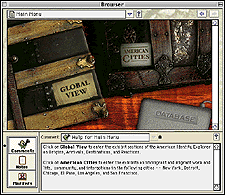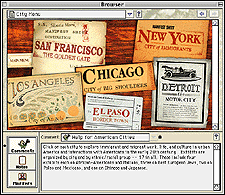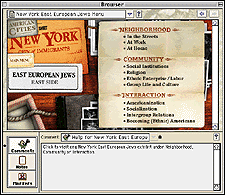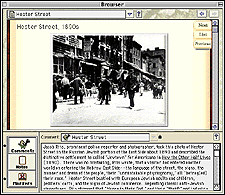
Navigate or search a diverse collection of artifacts

Visit six urban areas at the turn of the century

Explore ethnic groups within each destination city

Artifacts include photographs, stories, letters,
and more.
|
The
American Identity Explorer: Immigration and Migration
focuses on global migration and the social processes
by which millions left places of origin in Europe,
Asia, Mexico, and the American South, and traveled
to new destinations, especially to urban industrial
America. It also depicts a range of reactions by Americans
to mass immigration and migration, reflecting contemporary
movements to restrict immigration and to Americanize
and modernize the newcomers.
The CD-ROM also explores the experiences
of the newcomers in the places they settled, concentrating
on seven migrating groups in six cities--New York,
Chicago, Detroit, El Paso, Los Angeles, and San Francisco.
It examines the conditions newcomers encountered in
the neighborhoods and work places where they clustered,
the social and cultural lives they transplanted and
created, and their interactions with America and Americans.
The immigration and migration collection
is organized in two major parts, Global Views and
American Cities. Global Views contains four major
sections titled Origins, Arrivals, Destinations, and
Reactions. Migrating groups can be followed from their
places of origin through several American border stations
to interior destinations. American Cities includes
six major city sections sub organized by migrating
groups--17 exhibits in all. The groups include African-Americans,
Italians, East European Jews, Poles, Mexicans, Chinese,
and Japanese.
The collection brings together several
thousand photos, maps, documents, works of art, texts,
and faculty comments. In all, it represents a unique
compilation, with more content than individuals can
view in a limited time. The archive is conceived as
an interactive learning environment into which individuals
can enter and initiate their own explorations. Accompanied
by advanced viewing, searching, note taking, and organizing
tools, the collection provides a rich base to explore
a variety of issues and topics related to immigration,
migration, and American identity.
The American Identity Explorer CD-ROM
runs on Macintosh, Windows 3.1, and Windows 95/NT
and requires 16 MB of RAM.
|

